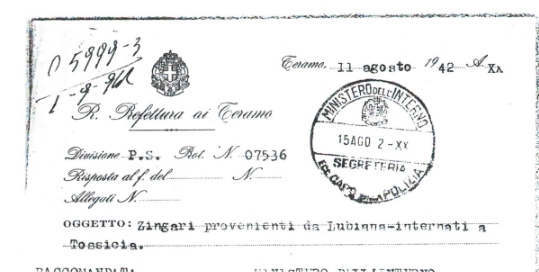
The history of the Tossicia camp is linked to the project to purge Sinti and Roma in Istria. Rave Hudorovic had already spoken about it:
‘Then one day we were standing in a place, Rasuplje is its name, and the Italians arrived. We were many Sinti together, fifty people, maybe more. My wife’s whole family was there. They came in a truck and said ‘get ready, we’re going to Ljubljana’. Everyone packed their bundle and off we went […] When we arrived in Ljubljana they told us they were taking us to Italy and we were very happy. In Ljubljana they put us together with many other Sinti. We stayed in Ljubljana for a week, then by train to Tossicia, near Teramo. I don’t remember exactly what month it was, but it was summer, maybe July. I was in Tossicia for eighteen months […] in Tossicia we were all Sinti together […] one day we heard that the Germans had arrived and we were off to the mountains. From Tossicia to Bologna, never on the plain but always in the mountains. In the mountains we were together with the partisan rebels. We always went on foot, even when I had to cross the streams, I carried Anton on my back, I had to cross, because otherwise the fascists would catch me… they would kill people’.
Giuseppe Levakovic’s account confirmed this:
‘Here in Teramo we met a Romnì who went begging […] He told us that he was in the concentration camp with about eighty people from Yugoslavia who had been taken near Trieste. The Roma locked up there lived in miserable conditions, in shacks and slept on the floor even without a bed, they had little to eat and were rationed’.
The Tossicia camp consisted of three buildings. Two of them, the one owned by Giulio De Fabii and Francesco Mattei and the one owned by the lawyer Domenico Mirti, both in Piazza Regina Margherita, were used as concentration camps in June 1940. While the premises owned by Alfredo Di Marco were only rented, by the Ministry of the Interior, in November 1941. The camp was directed until its closure by podestà Nicola Palumbi, assisted by vice podestà Mario Franceschini and municipal secretary Michele Marano. Supervision was guaranteed by the marshal and four carabinieri from the local station, which was located about fifty metres from the first two buildings. The first deportees arrived in Tossicia in August 1940, and were almost all German Jews. On 16 September, after the arrival of some Chinese, the camp reached 27. In the following month more Chinese were sent by the Ministry of the Interior to Tossicia and by November 1940 the camp was almost entirely occupied by 112 internees. During 1941, the few internees of German nationality were transferred, and only the Chinese remained in Tossicia. The camp, in the first months of 1942, was now complete, the internees, forced to live in a small space and in very poor hygienic conditions, began to show signs of intolerance.
On 16 April 1942, six Chinese, suffering from scabies, were removed from the camp. A month later, the Chinese interned in Tossicia were transferred to the Isola del Gran Sasso camp. Following the transfer of the Chinese, the camp remained empty until 22 June, when the first 35 ‘gypsies’ arrived from Ljubljana. In the following July other ‘gypsies’ were sent to Tossicia, and the camp reached 115 in the autumn of 1942. They were all Slavic Roma and Sinti and the Istrian prefect Berti could declare in that same year that he had cleared Istria of the presence of ‘gypsies’.
In January 2013, in Tossicia too, the Memors project, in cooperation with the municipality, placed a plaque in memory of the families interned there. Giorgio Bezzecchi, the son of Goffredo Mirko Bezzecchi, one of the former internees, unveiled the plaque. The families who were interned there were called: Brajdic, Hudorovic, Levakovic, Rajhard (Reinhardt) and Malovac. The lists of 108 Roma and Sinti interned in that camp since 1942 were first published in 1985 by Italia Iacoponi in the essay that appeared in the ‘Rivista abruzzese di studi storici dal fascismo alla resistenza’.
References:
Testimonies collected and published in 1983 by Jane Dick Zatta under the title La storia di Rave and fragments reproduced in M. Karpati, La politica fascista verso gli zingari, op. cit., p. 43.
